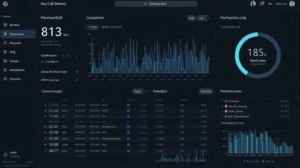The Power of Conversation Intelligence: What It Is and Why You Need It
Conversation intelligence is the use of AI to analyze customer calls and interactions—turning spoken conversations into actionable insights that help businesses improve sales, marketing, and customer experience.

In today’s digital-first world, every business conversation tells a story—about your customers, your team, and your results. But unless you’re recording and analyzing those conversations, that story remains untold.
That’s where conversation intelligence steps in.
This technology captures, transcribes, and analyzes phone calls or voice interactions to uncover valuable insights—what customers care about, how agents perform, and what drives conversions.
If you’ve ever asked, “How can I understand what’s really happening in my sales calls or support conversations?” — this is the guide you’ve been looking for.
In this post, we’ll explain what conversation intelligence is, how it works, why it matters, and how it transforms sales, marketing, and customer success for small and large businesses alike.
What Is Conversation Intelligence?
Conversation intelligence is an AI-powered technology that listens to, records, and analyzes human conversations—especially voice calls between businesses and customers.

It uses speech recognition, natural language processing (NLP), and sentiment analysis to extract meaning, emotion, and intent from spoken words.
In simple terms:
It turns your calls into data, your data into insights, and your insights into growth.
With conversation intelligence tools, companies can:
-
Identify patterns across hundreds of calls
-
Measure sentiment and emotion
-
Detect buying signals and objections
-
Coach sales teams based on real interactions
-
Improve marketing and service based on real-time feedback
Think of it as having an AI assistant who listens to every conversation and highlights exactly what matters.
How Does Conversation Intelligence Work?
The process might sound complex, but it’s elegantly simple when broken down:
Step 1: Call Recording
Every conversation—whether inbound, outbound, or virtual meeting—is securely recorded.
Step 2: Speech-to-Text Conversion
AI converts audio into accurate, searchable text using speech recognition technology.
Step 3: Natural Language Processing (NLP)
The system analyzes what was said, who said it, and how they said it. NLP identifies keywords, topics, and emotions in each exchange.
Step 4: Sentiment & Emotion Detection
The tool detects positive, neutral, or negative sentiment, helping teams measure customer satisfaction instantly.
Step 5: Insight Generation
Key takeaways are summarized—customer pain points, product mentions, objections, opportunities, and next-step triggers.
Step 6: Dashboard Reporting
All insights are displayed in intuitive dashboards showing metrics like talk-to-listen ratio, keyword frequency, and call outcomes.
Result: You get actionable intelligence from every conversation—without listening to every minute.
Why Conversation Intelligence Matters in 2025
Businesses today handle thousands of voice interactions every month—through phone calls, meetings, and support lines. Without automation, nearly 90% of valuable insights from these conversations go unused. That’s where conversation intelligence comes in—it transforms spoken interactions into actionable data that drives growth across sales, marketing, and operations.

Here’s why it’s essential in 2025:
-
Better Sales Coaching
Conversation intelligence tools analyze what top sales performers say differently—their tone, phrasing, and timing. This helps managers train new team members faster with data-backed examples of what truly converts. -
Enhanced Customer Experience
AI can detect frustration or confusion in real time, allowing support teams to step in before an issue escalates. This proactive approach builds stronger customer relationships and loyalty. -
Smarter Marketing Decisions
By identifying recurring patterns like “price too high” or “delivery delay,” marketers can refine campaigns, adjust pricing strategies, and create content that directly addresses customer pain points. -
Operational Efficiency
Instead of manually reviewing hundreds of random calls, managers can focus only on the 10% that truly matter—those automatically flagged by the system for coaching or compliance review. -
Compliance & Quality Assurance
Conversation intelligence ensures sales and service reps follow required scripts and disclosures, helping businesses avoid compliance risks and maintain consistent brand standards.
In 2025, conversation intelligence is no longer a nice-to-have—it’s a strategic necessity. It bridges the gap between customer conversations and company decisions, making every call a source of growth.
Learn more about leveraging AI-driven insights for smarter business decisions at VoiceTotal Blog.
Key Benefits of Conversation Intelligence for Businesses
Let’s explore how conversation intelligence technology transforms organizations of every size:
-
Improves Sales Conversions: By understanding what customers actually say—phrasing, tone, objections—your sales team can respond better, handle objections faster, and close more deals.
-
Streamlines Training & Coaching: Instead of guessing which calls went well or poorly, managers can review real examples of high-impact moments in conversations and coach based on data, not hunches. Calabrio
-
Boosts Marketing ROI: Conversation data reveals which campaigns drive calls and what customers mention most—closing the gap between marketing activity and real sales outcomes.
-
Increases Customer Retention: AI flags unhappy customers or risk indicators before they churn, enabling proactive follow-up that saves relationships and reduces attrition.
-
Saves Time & Resources: Automation replaces hours of manual review, freeing teams to focus on strategy and service instead of spreadsheets and missed insights. Nextiva
In short, conversation intelligence isn’t just a tool for call centres — it’s a strategic asset for sales, marketing, operations, and customer experience teams. By turning everyday conversations into structured, actionable insights, you gain clarity, effectiveness, and measurable results. IBM
For deeper insight into how businesses are leveraging call- and conversation-analytics to drive growth, visit this article on one of the leading AI analytics platforms.
Conversation Intelligence vs. Call Tracking: What’s the Difference?
Many businesses already use call tracking software to attribute leads to ads or keywords. That’s an excellent start—but conversation intelligence goes further.
| Feature | Call Tracking | Conversation Intelligence |
|---|---|---|
| Measures Calls | Tracks source & duration | Analyzes full content |
| Reveals Keywords | Basic | Advanced NLP recognition |
| Detects Sentiment | ❌ | Positive/negative tone analysis |
| Coach Sales Teams | ❌ | Records & highlights best practices |
| Automates Insights | ❌ | AI-driven summaries & trends |
![]()
Together, call tracking + conversation intelligence form a complete call analytics ecosystem, combining attribution with understanding.
Real-World Use Cases
Conversation intelligence is industry-agnostic—it delivers value anywhere communication matters.
1. Sales Teams
Identify top closers, learn what language wins, and automate post-call summaries.
2. Customer Support
Spot common complaints, analyze tone trends, and improve scripts to resolve faster.
3. Marketing Teams
Map voice-of-customer data to campaigns, uncover pain points, and refine landing pages based on real call language.
4. Healthcare & Insurance
Ensure compliance, detect stress indicators, and improve agent empathy.
5. Financial Services
Monitor disclosures and detect at-risk conversations while ensuring high service standards.
How VoiceTotal Brings Conversation Intelligence to Life
VoiceTotal isn’t just another analytics platform—it’s designed to make conversation intelligence accessible, affordable, and actionable for growing businesses.

Here’s how it helps:
1. Unified Call Intelligence
Integrates call tracking + AI analysis in one simple dashboard.
2. Real-Time Sentiment Scoring
Instantly measures customer emotions and satisfaction.
3. Smart Agent Scoring
Automatically grades agent performance, helping managers coach with precision.
4. Keyword & Intent Tracking
Surfaces trending topics, product names, and common objections.
5. Actionable Reports
Daily or weekly summaries show what’s improving—and where to focus next.
VoiceTotal’s approach focuses on data clarity, ease of use, and ROI visibility—three things small teams value most.
Implementation Tips: How to Get Started
-
Record Every Call: Whether inbound or outbound, make sure all voice interactions are captured securely.
-
Connect to CRM: Sync customer data so context (name, campaign, value) is linked to every conversation.
-
Define Key Metrics: Choose what matters—sales conversions, satisfaction, or script compliance.
-
Set Up Alerts: Automatically flag calls with negative sentiment or missed keywords.
-
Coach Continuously: Use snippets in team meetings to illustrate good and bad examples.
-
Close the Loop: Feed insights back to marketing and product teams for continuous improvement.
Conversation Intelligence and Data Privacy
Compliance is non-negotiable. Reputable solutions like VoiceTotal maintain strict privacy standards:
-
GDPR and PDPA aligned
-
Encrypted recordings
-
Role-based access control
-
Secure cloud hosting with audit trails
Always ensure agents and customers are notified about call recording—transparency builds trust.
he Future of Conversation Intelligence
Over the next few years, expect even more integration and automation:
-
Multichannel coverage: Calls, video meetings, chat, and email combined in one AI lens.
-
Predictive analytics: Systems will forecast deal outcomes or churn risk from tone and word patterns.
-
Voice personalization: Real-time cues will help reps adapt tone mid-conversation.
-
Deeper CRM alignment: Conversation insights will automatically update contact records and deal stages.
-
AI coaching copilots: Real-time prompts guiding reps during live calls.
In short, conversation intelligence will shift from reactive analysis to proactive enablement.
1. i Challenges and Myths to Avoid
-
Myth 1: “It replaces managers.”
It empowers them with better data, not automation-only decisions. -
Myth 2: “AI can misunderstand tone.”
True, context matters—but hybrid models (AI + human review) fix that. -
Myth 3: “It’s too complex.”
Modern platforms like VoiceTotal make setup plug-and-play. -
Myth 4: “Only big enterprises need it.”
SMBs benefit even more—they gain insights previously locked behind enterprise budgets.
1. ii Key Metrics to Track
-
Sentiment Distribution: % positive vs. negative calls.
-
Talk-to-Listen Ratio: Ideal 40:60 balance improves engagement.
-
Keyword Mentions: Track brand/product names or competitor mentions.
-
First Call Resolution (FCR): Measure efficiency of issue resolution.
-
Agent Score Trends: Monitor improvement over time.
-
Customer Intent Topics: Discover what people are really asking about.
These metrics convert raw speech into strategic business intelligence.
1. iii How to Evaluate Conversation Intelligence Tools
When choosing a provider, assess:
-
Accuracy of transcription (multi-accent support).
-
Dashboards: clarity, filters, exportability.
-
Integration options (CRM, call software, APIs).
-
Security certifications (ISO, SOC 2).
-
Support & onboarding quality.
-
Transparent pricing—avoid per-minute billing surprises.
1. iv Real ROI from Conversation Intelligence
Companies that implement conversation intelligence typically see:
-
20–40% faster sales cycles.
-
25% higher lead-to-close rates.
-
30% fewer escalations in support calls.
-
Improved customer retention and satisfaction scores.
Why? Because they stop guessing and start listening at scale.
1. v Wrapping It All Together
The question isn’t “What is conversation intelligence?” anymore—it’s “How soon can you start using it?”
From sales and support to marketing and product teams, every department benefits from understanding customer language, emotion, and need.
The companies that listen—truly listen—will win 2025 and beyond.
Conclusion
Conversation intelligence is redefining how businesses communicate, coach, and grow. It captures every spoken detail from calls and meetings, converts it into searchable data, and surfaces insights that improve performance at every level. Instead of guessing why deals close or calls fail, companies see exactly what customers say, feel, and need. The result? Smarter training, stronger marketing, happier customers, and measurable ROI. As AI becomes mainstream, voice data will become one of the most valuable assets a business owns—fueling predictive analytics, real-time coaching, and deeper customer understanding. Platforms like VoiceTotal make this transformation accessible to small and midsize teams, not just enterprise giants. The key is action: record every call, measure sentiment, track intent, and use those insights to improve your people and processes weekly. In a world where authentic conversations drive loyalty, conversation intelligence turns talk into tangible growth—and that’s a competitive edge you can’t afford to ignore.
